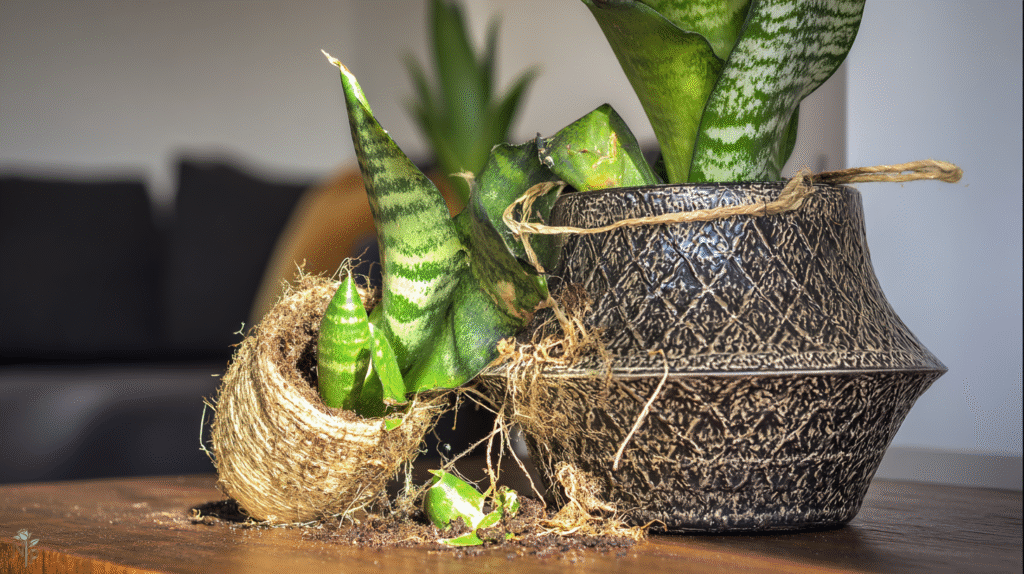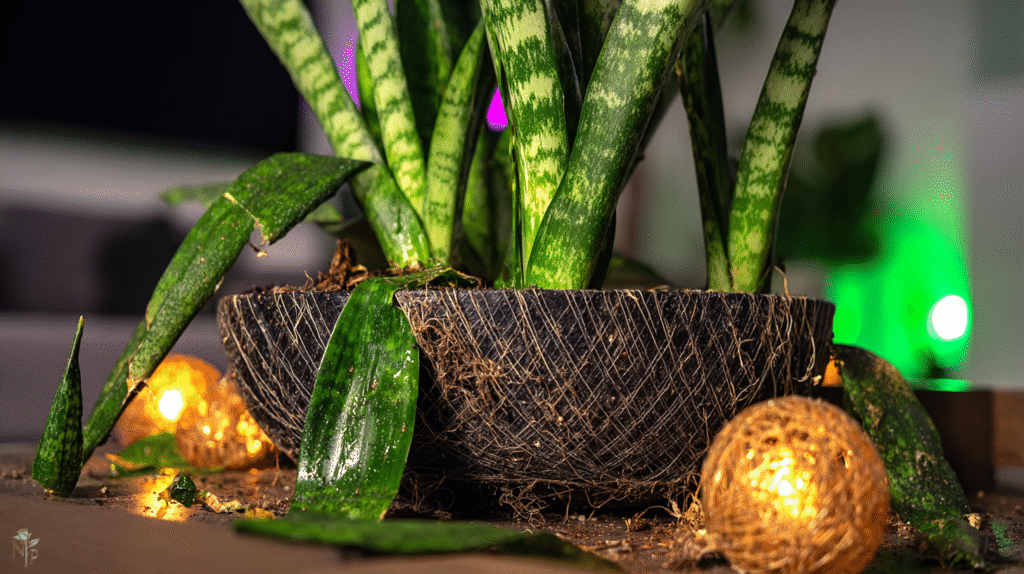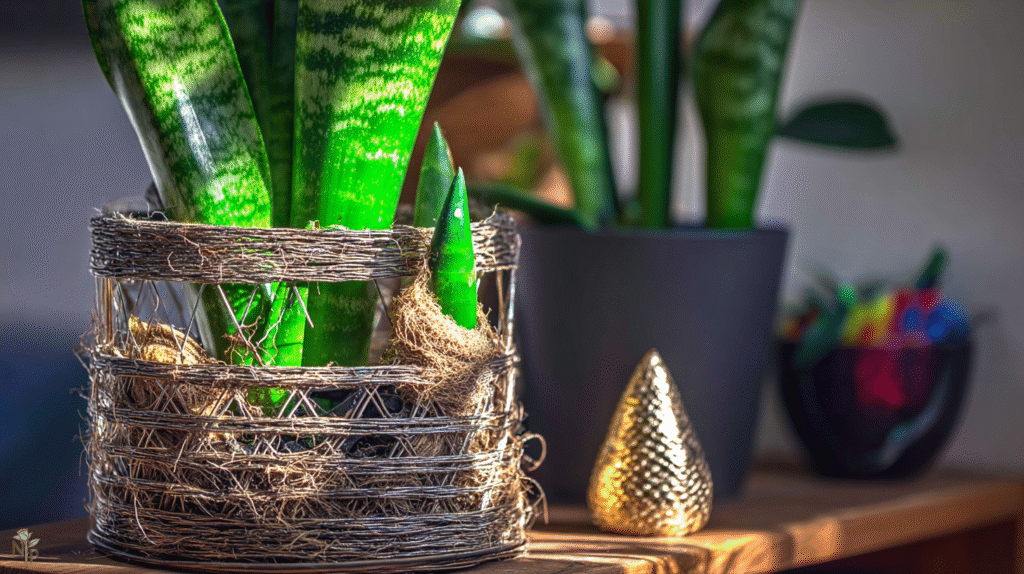Found my snake plant face-down on the kitchen floor last week. The cat knocked it off the counter, soil everywhere, half the leaves snapped, roots exposed and drying out. I stood there holding this disaster thinking “well, that’s $25 down the drain.”
That plant is now repotted, recovering, and already showing new growth. Because here’s the thing about snake plants – they’re harder to kill permanently than you’d think. I’ve brought back snake plants from root rot, sunburn, freezing, and complete neglect. My record? Reviving one that spent three months in a dark garage after a move. Three months. No water, no light, basically left for dead. It’s now five feet tall.
After rescuing probably a dozen snake plants (mine and friends’ who call me when theirs look dead), I’ve got this revival process down to a science. Here’s exactly how to bring a dying snake plant back from the brink, depending on what particular way you’ve managed to almost kill it.
Step 1: Figure Out What Went Wrong (The Plant Autopsy)
Before you can fix it, you need to know what broke it. Snake plants usually die from one of four things, and the fix is different for each.
The squeeze test: Grab a leaf near the base and squeeze gently. Mushy like a rotten banana? Root rot from overwatering. Firm but wrinkled like a deflated balloon? Underwatered. Firm but crispy? Sun or heat damage. Soft and yellow? Could be cold damage or overwatering.
The sniff test: Yeah, I’m telling you to smell your plant. Root rot smells like swamp ass. If your plant stinks when you get close to the soil, that’s your problem right there.
The root investigation: If you’re not sure, unpot it. I know it seems drastic, but you can’t fix what you can’t see. Healthy roots are white or light tan and firm. Rotted roots are black, mushy, and fall apart when touched. Dry, brittle roots mean underwatering.
Step 2: The Emergency Triage
Whatever the problem, some things need immediate attention:
Remove all damaged material: Dead leaves, mushy parts, anything black or yellow – cut it all off. Use clean scissors (I wipe mine with rubbing alcohol because I’m paranoid about spreading disease). Cut at the base where the leaf meets the soil. Yes, your plant might look pathetic with only two leaves left. It’ll grow back.
Clean the roots: If you’ve unpotted it, rinse the roots under lukewarm water. All that old soil needs to go, especially if there’s rot. I use an old toothbrush to gently clean them. Looks ridiculous, works great.

Step 3: The Root Rot Revival (Most Common Problem)
This is usually why snake plants die. Someone loves their plant to death with too much water. Been there, killed that.
Cut away the rot: Every black, mushy root has to go. Cut until you see white or tan tissue. Sometimes this means removing 90% of the roots. I once cut so much that I basically had a leaf with a stub. It grew new roots and survived.
The hydrogen peroxide treatment: After cutting, I spray the remaining roots with hydrogen peroxide (the regular 3% stuff from the pharmacy). It fizzes, which is oddly satisfying, and helps kill any remaining rot bacteria. Let it sit for 10 minutes.
Air dry before replanting: This is crucial. Let the whole plant air dry for 24 hours. I know it seems wrong to leave roots exposed, but trust me. Snake plants are succulents. They can handle it. The cut areas need to callus over to prevent more rot.
Replant in dry soil: Not moist, not slightly damp – DRY. Use cactus soil or make your own (I do 50% regular potting soil, 30% perlite, 20% coarse sand). Don’t water for at least a week. Two weeks if the rot was bad.
Step 4: The Dehydration Rescue (Less Common But Dramatic)
Underwatered snake plants look like someone let the air out of them. Leaves get wrinkled, lean over, might even fold in half lengthwise.
The gradual rehydration: Don’t just dump a gallon of water on it. Severely dehydrated roots can’t handle sudden moisture. Water lightly, wait a day, water a bit more. Over the course of a week, gradually increase water until the soil is evenly moist.
The shower method: For really dehydrated plants, I put the whole pot in the shower. Lukewarm water, gentle spray, let it run for about 30 seconds. The even, gentle watering prevents shock. Let it drain completely.
Recovery position: Put it in bright, indirect light (not direct sun) and wait. Seriously, just wait. It can take 2-3 weeks for leaves to plump back up. First sign of recovery is usually the leaves standing more upright.
Step 5: The Sunburn/Heat Damage Fix
Moved your snake plant outside for “fresh air” and cooked it? Yeah, done that. Leaves get bleached white or brown, crispy like chips.
Cut the damage: Sunburned parts won’t recover. Cut off the damaged portions. You can cut just the damaged part of a leaf – it’ll look weird but the plant doesn’t care.
Move to shade immediately: Not just “less sun” – actual shade for at least two weeks. The plant is traumatized and needs recovery time. I put sunburned plants in the darkest corner of my living room initially.
Gradual reintroduction to light: After two weeks in shade, gradually move it closer to its final spot over another two weeks. Rushed this once and re-burned the same plant. Felt like an idiot.

Step 6: The Propagation Backup Plan
Sometimes a snake plant is too far gone to save whole. But if even one healthy leaf section remains, you can grow a new plant.
Emergency propagation: Cut a healthy leaf into 4-inch sections. Mark which end was up (I notch a small V at the top). Let them dry for 24 hours. Stick the bottom 2 inches into dry soil. Wait 3-4 weeks before watering. New plants will grow from the base.
Water propagation for desperate times: If the roots are completely gone but leaves are okay, you can root in water. Cut leaves, let dry for a day, then put in water. Change water weekly. Once roots are 2 inches, plant in soil. Takes about a month.
Step 7: The Recovery Room Setup
Where you put your recovering snake plant matters almost as much as the treatment.
Location: Bright indirect light, no direct sun. Stable temperature (65-75°F). Away from vents, drafts, or grabby pets. My recovery ward is a shelf near (but not in front of) an east window.
The waiting game: Don’t fertilize for at least two months. Don’t repot again unless absolutely necessary. Don’t move it around. Just water sparingly and leave it alone. Snake plants recover slowly but surely.
Signs of recovery:
- New growth (tiny shoots from the base)
- Leaves standing more upright
- Improved color (less yellow, more green)
- Roots growing (you’ll see them through drainage holes eventually)
My Current Snake Plant ER Success Stories
The garage survivor: Three months in dark garage, completely dry, several leaves dead. Cut dead parts, rehydrated slowly, now 5 feet tall.
The root rot disaster: Bought on clearance, 95% root rot. Cut everything, one leaf with stub remained. Six months later, four new shoots.
The frozen one: Left outside during unexpected freeze. Leaves turned to mush. Cut everything down to soil level. Roots survived, grew back completely in one growing season.
The cat attack victim: Knocked over, broken in half, roots exposed for who knows how long. Emergency repot, aggressive pruning. Lost half the plant but the rest recovered fully.

The Reality Check
Not every snake plant can be saved. If the roots and rhizome (the thick horizontal root thing) are completely rotted, it’s done. If all the leaves are mushy at the base, probably too late. But I’ve been surprised by how much damage these plants can take and still recover.
The key is acting fast once you notice problems, being ruthless about removing damaged parts, and then having patience. Snake plant recovery is measured in months, not weeks.
My most abused snake plant – the one that survived the garage, two moves, a cat attack, and chronic neglect – is now my biggest, healthiest specimen. Sometimes the ones that survive trauma come back stronger.
Just remember: when in doubt, cut the rot out, let it dry out, and give it time. Snake plants want to live. You just have to stop accidentally trying to kill them and give them a chance to prove it.






